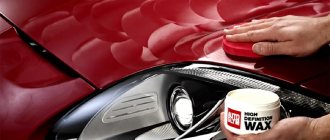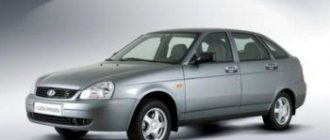When planning to purchase a new car, consumers usually look at descriptions of various models to choose the option that best suits their needs. The trouble is that the average person cannot always understand the specific terminology of the automotive industry.
Even the classification of cars by body type is not clear to everyone, since many still have only the vaguest idea of the differences between a sedan, hatchback and station wagon. Well, let's try to clarify this issue.
Liftback
A liftback is a type of closed car body that is intermediate between a sedan, station wagon and hatchback. It differs from the hatchback in the longer rear overhang: the liftback has the same length as the sedan. The rear part of the roof can be either sloping or (less often) stepped, reminiscent of a sedan.
Body type Liftback
Differences in car body types: sedan, coupe, hatchback, station wagon and others
The number of cars on our roads is constantly growing. Manufacturers, trying to please all customers, improve not only the “filling”, interior, design of the car, but also the body. For our comfort, they try to combine several designs in one body type, which results in more varieties, and they are so similar to each other. But you can distinguish them, and we will help you figure it out. The most common body types in our area are sedan, hatchback, station wagon, crossover, and SUV. Coupe, minivan, compact van, pickup truck are less common. Sedan
The sedan is the most popular body type among passenger cars in our country.
This is a three-volume body with four doors and a separate luggage compartment. Average ground clearance will allow you to travel both around the city and on the highway. The disadvantage is the small trunk, which is quite limited in height. The price of sedans varies greatly. From a huge selection you can choose a sedan of both B class and E class, it all depends on your preferences and financial capabilities. Examples of cars with the sedan body type Coupe
The coupe is also a three-volume body, the main difference from the sedan is the number of doors: the coupe has two.
The design is more understated, sporty, and therefore more powerful. Because there are only two, they are slightly larger than the sedan, which adds to the comfortable driving position. Among the minuses, in addition to the insufficient luggage compartment, we can note the inconvenient entry of second-row passengers. This type of body is suitable for travel by one passenger, and there are no plans to transport large items. Examples of cars with a coupe body type Hatchback 3-door and 5-door
Hatchback is a two-volume body type that differs from a sedan in the volume of the trunk: it is smaller, but the rear door starts from the roof, which will allow you to transport tall objects, and the second row folds seats will increase luggage space.
Suitable for purchase by novice drivers as a first car, because this body type is small-sized, very maneuverable, and ideal for the urban jungle. The main drawback is the low power, and in the three-door versions there is an uncomfortable seating position for passengers in the second row of seats. Examples of passenger cars with a hatchback body type.
A type of hatchback is a liftback.
This body type has a distinctive feature in the form of a small step on the fifth door (liftback - “lifting lid”). The trunk is connected to the rear window and opens with it. But in appearance, the liftback resembles a sedan and is often confused with it due to the protrusion on the luggage compartment lid. Station wagon
wagon is a two-volume type of passenger car body that has an increased luggage compartment compared to a sedan.
The passenger compartment and luggage compartment are connected, and the roof extends to the rear door. This is an advantage for choosing a family car: all family members can comfortably fit in the cabin, and all the cargo will fit in the luggage compartment. An example of a station wagon body type.
You can clearly understand the differences between a hatchback, a sedan and a station wagon using the example of the Chevrolet Cruze car.
The picture clearly shows the difference between body types from one to another. Crossover
Crossover is a two-volume body type.
This is something between an SUV and a station wagon, or less often a hatchback, combining the disadvantages and advantages of these different classes. The crossover differs from a hatchback in its higher ground clearance and, accordingly, increased cross-country ability, but does not reach the level of jeeps due to lower power and sometimes the presence of single-wheel drive. The crossover is a fairly popular car on our roads. It has the confidence of an SUV, the efficiency of a station wagon and the comfort of both driver and passengers, regardless of whether you are carrying luggage or not. To meet customer demand, manufacturers began to produce simplified all-wheel drive systems and produce one-wheel drive crossover models. They are used only in urban conditions, and off-road capability is practically no better than that of station wagons, which is why the expression “parquet SUV” or “SUV” for short began to appear among the people. Now this term is often used for all models with a crossover body type, without taking into account the actual cross-country ability parameters. Examples of cars with a crossover body type SUV or Jeep
An SUV is also a two-volume body type, and as mentioned just above, it is a car with a high degree of cross-country ability.
How to distinguish an SUV externally from another type of car body? An SUV is an all-wheel drive vehicle with a frame body, high ground clearance (more than 200 mm), and large wheels. Since this car was created for off-road travel, it is distinguished by high power and, accordingly, high fuel consumption. Therefore, among the disadvantages we can note: high cost (both purchase and costs for spare parts, refueling). This type of body is perfect for lovers of extreme types of recreation, solving the complex problems of Russian off-road, or can take a snowmobile, ATV, or jet ski with them, and for city residents, an SUV will be a prestigious and reliable car, but it will not be able to reveal its full potential. Examples of SUVs Pickup
There are also SUVs with a closed driver's cabin and a large open luggage compartment.
This body type is called a pickup truck. A pickup truck is a two- or four-door all-wheel drive (rarely rear-wheel drive) SUV with 1 or 2 rows of seats arranged in a 2, 2+1, 2+2, 2+3 pattern, which looks like a small truck. The main advantage of this car is the luggage compartment, which is unlimited in height. The cargo bed has a tailgate and can be installed with a soft top (with a hard top installed, the pickup turns into a van). A pickup truck is purchased by people whose line of work involves small-scale cargo transportation, as well as by people living outside the city, because transporting a dozen bags of crops on a pickup truck is a pleasure. Some models have a pickup body type.
There are also single-volume body types. These include buses of various sizes: minivan (mandatory presence of a third row of seats, sliding side doors, length of at least 4.5 m), compact van (smaller version of the minivan - length 4.2-4.5 m) and microvan (enlarged copy of the station wagon , length up to 4.2 m).
18.09.2015
Four-door coupe crossovers
This type of vehicle is a true indication that consumers have become more discerning in their tastes and more demanding of new models. Since the popularity of coupes has not been falling for a long time, and also due to the incredible popularity of crossovers and SUVs, it is logical that coupe crossovers should have appeared on the market.
This happened shortly after the appearance of the world's first modern crossovers. For example, the first to undertake a bold experiment en masse was ]BMW[/anchor], which released the four-door X6 crossover in a coupe body, which the public initially greeted with caution, but then the X6 quickly gained popularity despite criticism from experts.
Thanks to their high ground clearance, dimensions and spacious interior, four-door crossovers and coupe-style SUVs have begun to gain popularity from four-door coupe passenger cars. After all, we must admit that no one doubts the versatility and practicality of crossovers. Plus, the graceful lines of the coupe body give the SUV a luxurious appearance.
Including coupe crossovers, as a rule, they are light and powerful, unlike conventional SUVs and crossovers.
The main differences between a hatchback and a station wagon
Common features inherent in the hatchback and station wagon - both classes are a modified sedan with an essentially combined interior and trunk.
The differences between a hatchback and a station wagon are as follows:
- The size of the luggage compartment is significantly smaller in the Hatchback. The station wagon is excellent for cargo transportation and is often purchased by private entrepreneurs and medium-sized companies precisely for these purposes;
- The hatchback features a more elegant rear design. The inclined door looks much more beautiful than the strict vertical overhang of the station wagon. Women often make choices based on this;
- The station wagon is longer than the hatchback. This can be a significant drawback in urban environments if the car is used only for transporting passengers, but when it comes to large cargo, this is definitely an advantage;
- The hatchback can be supplied in a “sporty” 3-door configuration;
- Station wagons, as a rule, are more expensive than hatchbacks of the same series.
Both classes of passenger cars discussed in this article occupy their niche in the domestic market and are in demand among Russian motorists due to their features.
No, it’s not that the coupe is a two-seater car, and, of course, it’s not that the coupe has only two doors, and the sedan has four. Neither the headlights, nor the turn signals, nor the foglights, nor the grilles, nor much else is the real difference between a sedan and a coupe. Everything is much simpler.
Many car enthusiasts have difficulty determining the body type, especially when determining whether it is a sedan or a coupe. It is traditionally believed that a coupe has only two doors, and a sedan has four. But in reality there are both four-door coupes and two-door sedans, so the differences between them may not be so obvious.
The difference between these two body types is not the number of doors or the shape of the body, but the amount of interior space.
There are certain standards according to which a coupe is a car with rear seat space of less than 0.93 cubic meters. Accordingly, a sedan is a car with rear passenger space equal to or greater than 0.94 cubic meters. Therefore, two-door cars with a rear seat volume of more than 0.94 cubic meters are two-door sedans, but they are often sold as coupes. This is done in order to focus on the sportiness of the car and, for the most part, does not indicate the technical features and characteristics of the car, but the place it occupies in the market and the set of qualities that consumers need. This is a common marketing ploy that sellers use to attract the attention of buyers. This causes confusion among owners of such cars.
In fact, when deciding to buy a car, the most important thing is to pay attention to what it is called. Comfort, technical characteristics, and basic functions play a big role. For some, the determining factor may be appearance, and for others, price.
The number of car body types has almost doubled over the past 15 years. Manufacturers are increasingly trying to combine several body types in one car. It is becoming increasingly difficult to distinguish one option from another, but we will still do it.
To begin with, we will divide all body types into 3 groups: three-volume, two-volume and single-volume.
Liberals
The two-volume body does not have a protruding trunk, and its lid opens only with the glass and is considered another door.
Two-volume bodies include hatchbacks, station wagons, as well as crossovers and SUVs created on their basis. Two-volume bodies are distinguished by the most spacious luggage compartments (station wagons) and compact dimensions (hatchbacks).
Hatchback, station wagon
Now let’s talk about body types, because not only the cost and prestige of the car, but also comfort and even safety depend on this important parameter.
The most popular car body types:
- sedan
- hatchback
- SUV
- station wagon
- minivan
There are also body types such as liftback, limousine, pickup, van, convertible, roadster.
Let's look at the presented types in more detail.
Hatchback
The car body may have one or two rows of seats, depending on the configuration. A distinctive feature of this body type is the presence of a door in the rear wall and, most importantly, a shortened rear overhang. The last factor makes it easy to distinguish a hatchback by its appearance. As a result, the car's trunk is not as spacious as, say, a station wagon. But this design allows the hatchback to maneuver well in urban environments, which is why this body type is widely in demand in metropolitan areas. Another advantage is the possibility of easy parking. The actual combination of the passenger compartment and trunk also has a negative side: quite often, drivers and passengers complain about an unpleasant smell from the trunk if, for example, some products are transported there.
Toyota Prius NHW20 - hatchback example
Station wagon
A station wagon is a compromise between a car and a truck. These are cars created on the basis of hatchbacks with an elongated body and a large amount of luggage space. Passenger seats in station wagons fold and stow away, significantly increasing vehicle space and cargo capacity. A station wagon can have 3 or 5 doors.
Volkswagen Passat Passat
Conservatives
The three-volume body has a protruding hood and trunk. Three-volume vehicles are among the least versatile bodies due to the limited possibility of transforming the interior and trunk. This group includes sedans, coupes, convertibles and pickups.
Sedan, coupe
The most striking representative of the three-volume body is the sedan, which is present in the model range of almost all manufacturers. The sedan is considered the most conservative (classic) and prestigious body type. The sedan is extremely popular on our roads, where “prestige is everything,” and cars are divided into sedans and non-sedans.
A convertible is a coupe with a “soft” tent roof that folds behind the rear seats and rises if necessary.
But the soft top did not allow the car to be used all year round, so in the late 90s a new version of the open body began to gain popularity - the coupe-convertible. At first glance, it looks like a regular coupe, but when you press the right button, the hard metal roof lifts up and neatly folds into the trunk, turning the coupe into a convertible.
A two-seater convertible (without a second row of seats) is called a roadster (for example).
Pickup
A pickup truck is a body with an open cargo area separated from the interior by a rigid partition. Simply put, it is a smaller copy of a regular truck. Most pickup trucks are built on the same platform as SUVs and have good cross-country ability. Both here and throughout Europe, pickup trucks are not particularly popular, but in the USA they are crazy about them.
SUV
An SUV is a type of closed car body with increased cross-country ability and increased ground clearance.
A crossover is a type of closed car body that combines the properties of an SUV and a station wagon or hatchback.
A pickup truck is a type of commercial two-seater vehicle with an open cargo bed.
A van is a type of enclosed body of a commercial two-seater vehicle with an enclosed cargo bed (luggage compartment with a door on the rear wall).











